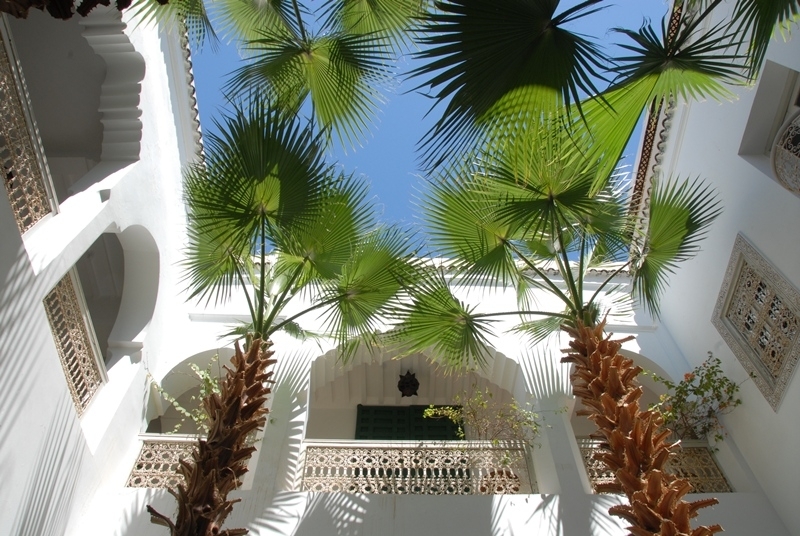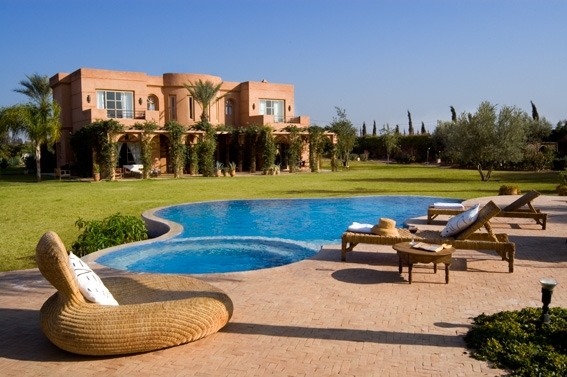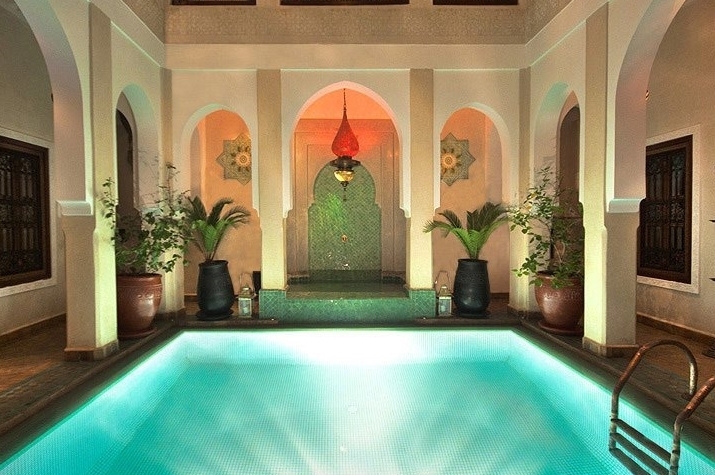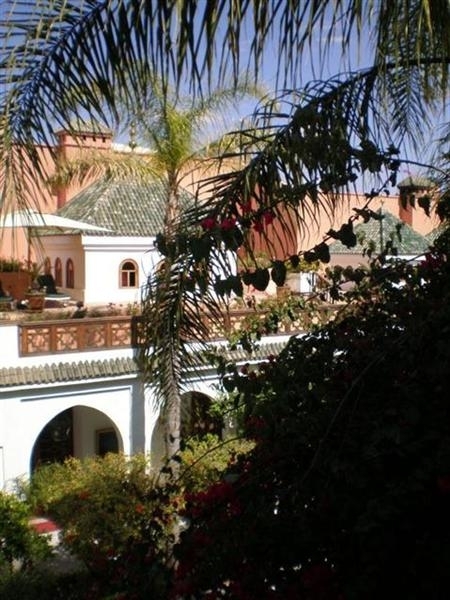Marrakesh is an exotic city buzzing with life set against the backdrop of the magnificent Atlas Mountains. Marrakech is a place which floods the senses with strange and overwhelming sights, sounds and smells, casting a heady spell over the unsuspecting traveller. It is the place where Arabia  meets Africa. Marrakech. has many wonders for the first time visitor.  There are many places to visit in Marrakech and some of the most amazing restaurants in terms of décor, style and food. Some of the most popular places are listed below:
The Koutoubia mosque is one of Marrakeshs’ landmarks. It is approximately 221 feet high, and is the largest mosque in Marrakech, Morocco. The minaret of the mosque was completed at around 1195. The mosque is named after the arabic word for library, since it was orignally used as a library and a mosque. There are 6 rooms inside the minaret, with a wooden scaffold at the top of the tower to assist the deaf by showing when prayers begin. It is built in a traditional Almohad style and the tower is adorned with four copper globes. According to legend, the globes were originally made of gold, and there were supposed to have been only three globes. The fourth globe is said to have been donated by the wife of Yacoub el-Mansour as dispensation for her failure to keep the fast for one day during the month of Ramadan, with¬†her gold jewelry being¬†melted down to provide the gold to cover¬† the fourth globe.
It is just a beautiful mosque, and the best time to photograph it in all its glory is at sunset.  The mosque is not open to non-muslims. However, it is always nice to walk around the outside as there is so much to see.
The Majorelle Gardens are a must see for all visitors to Marrakesh. They are beautiful with lots of nooks and crannies, and often exhibit a marvellous sense of tranquility. They were the creation of ¬†Jacques Majorelle, who¬†was born in 1886 in Nancy (France). Jacques Majorelle was¬†the son of the celebrated art nouveau furniture designer Louis Majorelle, and¬† studied art at the Ecole des Beaux-Arts and later at the Academie Julian in Paris.¬†¬†Jacques Majorelle settled in Marrakech in 1919, where he worked as an artist and soon purchased the area which was to become the Majorelle gardens.¬† And although Majorelle’s orientalist watercolors are largely forgotten, many are preserved in the villa’s collection held within the garden which he created in 1924, and opened to the public in 1947. The Majorelle Gardens are now considered to be his greatest masterpiece, and hosts more than 15 bird species, which can be found only in this area of North Africa. The special shade of bold cobalt blue which he used extensively in the garden and its buildings is named after him majorelle blue.
Following a car accident, Jacques Majorelle returned to france, where he died in 1962.  In 1980 Pierre Bergé and Yves Saint Laurent purchased the garden and restored it to its former glory.  The garden now also houses the Islamic Art Museum of Marrakech, which shelters the magnificent Islamic art collection of Pierre Bergé and Yves Saint Laurent as well as ceramics, jewelry, and paintings by Majorelle. After Yves Saint Laurent died in 2008 his ashes were scattered in the Majorelle Gardens.
The gates or Babs of Marrakesh.  There are 19 Babs of Marrakech.  Bab Agnaou was built in the 12th century in the time of the Almohad dynasty. Bab Khemis is famous for it’s Thursday market.  Bab means gate and Khemis means Thursday.  If you are looking for cheap antiques or old doors than look at Bab Khemis.  It is most well known for it’s market.  I must say I thought this Market was open every day and that has been my experience, although technically it is apparently only open on Thursdays, but I think you disregard that last remark as it does not ring true.   Bab Laksour is a convenient place to be dropped off for the souks, and is also near to Vanessa Branson’s Riad El Fenn, as well as the renowned restaurant Le Tobsil.  When staying in a Marrakech riad, find oput your nearest Bab, as taxi drivers know every gate in Marrakech. 
The Marrakech Souks are mainly or technically only in the northern part of the medina of Marrakesh (i.e. north of the Jemaa El Fna), although to tourists they are everywhere in the medina, both north and south.   The souks are a labyrinthine network of alley ways or derbs with market stools or shops.  They tend to be divided into categories such as shoes, metal, cloths etc.  To the western eye, one wonders why anyone selling shoes would want to set up shop next to forty other shops selling shoes, and I still ponder this question. It is probably some local ruling, and yet one does find oddities amongst the herd. It is nice to simply amble through the souks, although we always recommend getting a good guide (hipmarrakech.com can advise on this).  The souks are generally open from about 9 or 10am til between 7-9pm.
However, when shopping with a guide, you have to understand that they often get a cut of whatever you buy (maybe 5-10%), but there again if you find something you want, you are unlikely to find it again the next day, so just accept the way things are, providing the price is right for you.  You MUST always barter.  In the west we are not used to bartering.  And also, we are not used to shop keepers assuming that if you ask the price you may just be curious than being a serious buyer of sorts.  If you like something, decide how much you would be prepared to pay and, after asking the price, and assuming it is being offered at a stupid price,  offer between one third to 50% of the maximum price you would be prepared to pay, and take it from there.  Do not go above what you are prepared to pay.  If you ask the price first without thinking, go at 20% or one fifth of the asking price and see what happens. You will see amazing hystrionics, but if they want to sell they will come back.  Just be hard and firm.  I remember bartering for three hours to buy some antique door latches, but I got a damn good price!!  You won’t have that time to be honest, but don’t be ripped off.  The only MUST SEE souk is the metal souks.  If you walk into the souks from Rue Dar El Bacha they are to your left as you get into the souks properly.  I was mesmerised when I first saw them, and everytime I go there I am just spellbound.
Calèches in Marrakech are horse-drawn carriages that hold four to five people. They are a great way to reach your dinner destination or have a relaxing tour of the town.  Young children love them, and older children are just embarrassed, if you know what we mean. They are also ideal to visiting the Majorelle gardens or the Menara and Agdal gardens.
Beware, and always agree on a price before you start your ride. In general it costs about 120-180 dhs per ride.¬† Trips to the Palmerie and around the ramparts might cost 200-300 Dhs.¬† The actual price to Moroccans is always lower, but life is too short to try and expect the bargain of the century in Marrakesh. ¬†The main pick-up stop is in the medina, along the left side of the street stretching from the Djem√Ęa el Fna to the Koutoubia Mosque.
The Saadian Tombs in Marrakesh were sealed up for centuries, and for various bizarre reasons they were not discovered until 1917.  They are situated in the kasbah, an area of the medina, Marrakech. The Saadian tombs in Marrakech date back to the rule of sultan Ahmud al-Mansur (1578-1603), and were built at around the same time as the Ben Youssef Medersa, and are magnificently decorated.
When Moulay Ismail (1672-1727) became ruler in Marrakesh, he destroyed the adjacent Badi Palace but superstition probably kept him from interfering with the burial ground. Instead, he sealed up all the entrances to the Saadian Tombs, and the site remained hidden from view until 1917 when they were apparently discovered during a French aerial survey, and a passageway was built from the side of the Kasbah Mosque. Although how, local people were not curious about what lay behind the walls amazes me.¬† The tombs’ long neglect has ensured their preservation and they have since been fully restored.
The tombs are a major attraction for visitors of Marrakech. The two main mausoleums, with 66 tombs laid out within them and over 100 more outside in the gardens. The first mausoleum, is on the left as you enter, and is the finest of the two. The mausoleum contains the remains of members of the Saadi dynasty. The building is composed of three rooms, the most famous of which contains 12 columns. The second mausoleum is older and was built by Ahmed el Mansour in place of an existing pavilion over the tombs of his mother and the founder of the Saadian dynasty. Scattered around the gardens are the tombs of over 100 more Saadian princes and members of the royal household, including a few Jewish graves. The gravestones are covered in tiles and many have inscriptions from the Koran.



